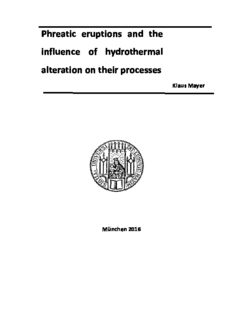
Phreatic eruptions and the influence of hydrothermal alteration on their processes PDF
Preview Phreatic eruptions and the influence of hydrothermal alteration on their processes
Phreatic eruptions and the influence of hydrothermal alteration on their processes Klaus Mayer München 2016 This page was intentionally left blank II Phreatic eruptions and the influence of hydrothermal alteration on their processes Klaus Mayer Dissertation an der Fakultät für Geowissenschaften der Ludwig–Maximilians–Universität München vorgelegt von Klaus Mayer aus Vilsbiburg (Deutschland) München, den 2. März 2016 III This page was intentionally left blank. IV Erstgutachter: PD. Dr. Bettina Scheu Zweitgutachter: Prof. Dr. Donald B. Dingwell Tag der mündlichen Prüfung: 25.07.2016 V This page was intentionally left blank. VI Abstract Phreatic eruptions are possibly the most drastic surface expressions of hydrothermal activity within active epithermal systems (geothermal fields), and they are still poorly understood. Various phenomena, such as fumaroles, hot springs, mud pools, and soil encrustations represent further obvious features of the interaction between outgassing hydrothermal fluids and the host rocks. Investigation of rocks outcropping in the proximity of such phenomena aimed to provide insights concerning the effects of hydrothermal alteration on phreatic eruption dynamics within volcanic systems. This dissertation presents the results of three individual case studies focusing on the influence of surficial hydrothermal alteration on petrophysical properties and in turn on phreatic eruption processes. Key question is, whether alteration increases the potential for such eruptions or not. Based on the findings of this study hydrothermal alteration changes the rock physical and mechanical properties and can have major effects on the permeability of surficial lithologies. The observed degradation processes were successfully related to the degree of alteration, which is represented by chemical weathering indices. The precipitation of secondary minerals and the formation of clay minerals can lead to the development of a mineralogical seal and a low permeable cap rock, respectively. Both processes might hinder the outgassing and favor the pressurization within the subsurface. Depending on the composition and temperature of fluids as well as on host rock composition and permeability, alteration can also be dominated by mineral dissolution resulting in an increased outgassing. The observed variability in alteration processes within very similar geological and hydrothermal settings highlights the complexity involved in the dynamics of hydrothermal systems. Furthermore the results showed that secondary mineralization induced by hydrothermal alteration might have a significant effect on the dynamics of phreatic eruptions and on the nature of phreatic ejecta. Surge deposits intensely affected by solfataric alteration generate abundant fine particles during fragmentation. Very fine ash, which possesses a silica- and alumina-rich composition due to alteration, may be a causative agent of respiratory diseases, and its dispersion could represent a serious health hazard on a local scale. In addition to the effects of hydrothermal alteration this study furthermore highlighted the influence of fluid type (liquid vs. gaseous) within the pore space on the phreatic eruption dynamics. Under identical pressure and temperature conditions, eruptions accompanied by the process of liquid water flashing to steam are significantly more violent than those driven simply by gas or steam expansion. VII Phase changes during decompression together with the type and degree of alteration are important fragmentation variables. Therefore they should be considered for hazard assessment and modeling of phreatic eruptions in hydrothermally active environments. VIII Kurzfassung Phreatische Ausbrüche zählen zu den drastischsten Auswirkungen von hydrothermaler Tätigkeit in aktiven, epithermalen Regionen (Geothermalfelder). Weitere offensichtliche Merkmale der Wechselwirkungen zwischen austretenden hydrothermalen Fluiden und dem Nebengestein sind Fumarolen, heiße Quellen, Schlammlöcher und Bodeninkrustationen. Um Einblicke in den Vulkanismus, vor allem in die wenig erforschten Prozesse der phreatischen Ausbrüche zu bekommen, wurden die Gesteine in der nahen Umgebung solcher Erscheinungsbilder untersucht. Im Rahmen dieser Dissertation werden die Ergebnisse aus drei eigenständigen Fallstudien vorgestellt. Untersucht wurden die Auswirkungen oberflächlicher, hydrothermaler Alteration auf gesteinsphysikalische Eigenschaften und folglich auf die Prozesse phreatischer Ausbrüche. Dabei stellt sich die Kernfrage, ob Alteration die Wahrscheinlichkeit derartiger Ausbrüche erhöht, oder nicht. Als Ergebnis dieser Studie kann festgehalten werden, dass hydrothermale Alteration die gesteinsphysikalischen und mechanischen Eigenschaften verändert sowie eine bedeutende Auswirkung auf die Permeabilität oberflächennaher Gesteine haben kann. Zusätzlich ist es gelungen, die Verschlechterung der Gesteinseigenschaften mit dem Grad der Alteration in Zusammenhang zu bringen, welcher von chemischen Verwitterungsindizes abgeleitet werden konnte. Die Ausfällung von Sekundärmineralen sowie die Bildung von Tonmineralen kann zur Ausbildung eines dichten Gesteinsverbandes bzw. einer geringdurchlässigen Deckschicht führen. Diese beiden Prozesse können die Entgasung behindern und damit zu einer Druckerhöhung im Untergrund führen. Alteration kann hingegen, abhängig von der Zusammensetzung und der Temperatur der Fluide, sowie des Mineralbestands und der Permeabilität des Nebengesteins, auch eine maßgebliche Lösung von Mineralen bewirken, was wiederum zu einer Erhöhung der Durchlässigkeit führen kann. Die Variabilität der Alterationsprozesse innerhalb sehr ähnlicher geologischer und hydrothermaler Umgebungen zeigt die Komplexität hydrothermaler Systeme und deren Abläufe auf. Des Weiteren verdeutlichen die Resultate, dass die Sekundärmineralisation signifikante Auswirkungen auf die Ausbruchsdynamik und die Eigenschaften phreatischer Auswurfmassen hat. Pyroklastische Dichtestromablagerungen, die intensiv von solfatarischer Alteration betroffen sind und fragmentiert werden, erzeugen eine immense Menge an Feinpartikeln. Sehr feine Aschepartikel, welche aufgrund der Alteration reich an Siliziumdioxid und/oder Aluminium sind, können Erkrankungen der Atemwege hervorrufen. Daher kann deren Freisetzung eine ernsthafte gesundheitliche Gefährdung im der Umgebung des Ausbruchs darstellen. IX Zusätzlich zu den Auswirkungen hydrothermaler Alteration wurden die Einflüsse des Fluidtyps (flüssig bzw. gasförmig) im Porenraum, auf die Dynamik phreatischer Ausbrüche untersucht. Ausbrüche bei denen es zu explosionsartigem Verdampfen von überhitztem Wasser kommt, sind bedeutend energetischer als jene, die lediglich von Gas- oder Dampfausdehnung getrieben werden – Voraussetzung ist die Annahme identischer Druck- und Temperaturbedingungen. Sowohl der Phasenübergang von Fluiden bei der Dekompression, als auch der Typ und Grad der Alteration, sind wichtige Parameter der Fragmentation. Daher sollten sie bei der Gefährdungsbeurteilung sowie der Modellierung von phreatischen Ausbrüchen in hydrothermalen Gebieten, berücksichtigt werden. X
Description: